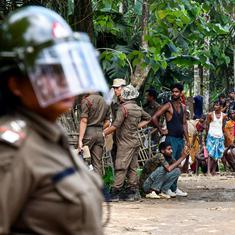Nepal was thrown into turmoil on Tuesday after its main Maoist party withdrew support to a nine-month-old coalition government led by Prime Minister KP Oli.
The Communist Party of Nepal (Maoist-Centre) had made a similar announcement withdrawing support in May, but it was swiftly reversed overnight under pressure from China.
Though Oli is reluctant to leave the government and is preparing to face the “note of dissent” in Parliament, leaders of his Communist Party of Nepal (Unified Marxist–Leninist) want him to resign.
The next government is likely to be headed by Communist Party of Nepal (Maoist-Centre) chairman Pushpa Kamal Dahal, also known as Prachanda, in alliance with the Nepali Congress, which is led by Sher Bahadur Deuba. The two parties reportedly struck a seven-point deal before the Maoists withdrew support to Oli.
The Maoists say Oli has broken promises he had made in the past. They have accused him of failing to accelerate the rebuilding of homes, roads and other infrastructure following the massive 2015 quake in Nepal, as well as failing to create a consensus for the implementation of the new Constitution, which was adopted last September but has been opposed by several parties who are agitating against the new statute.
Mending ties
Any new government in Nepal will have to make concrete efforts to bring the relationship between India and Nepal – which sank to its lowest ever under Oli – back on track.
The relationship deteriorated significantly after Nepal adopted its first post-monarchy Constitution last year, which was opposed by its ethnic and linguistic minorities who include the Madhesis – a term for several communities living in Nepal's central and eastern plains who have close cultural and family ties to India. These minorities fear the new statute will perpetuate the discrimination they have long faced.
New Delhi’s stance that Nepal must address the demands and aspirations of its minorities in its Constitution led to tensions between the two countries and pushed Nepal closer to China.
Last year, a prolonged and deadly agitation in the Terai – the low-lying plains contiguous with India – against the new Constitution in which over 50 people died was followed by a blockade, which cut off supplies to Kathmandu bringing it to a halt.
Nepal blamed India for supporting the blockade and anti-India sentiment was evident on Kathmandu’s streets during that time.
When the Nepali Congress and Prachanda’s party attempted to dislodge the Oli government in May, India was assumed to be behind it. This time too, India is likely to be accused of causing turmoil in the Himalayan nation, which has been plagued by political instability in recent years.
Internal grievances
However, fixing the India-Nepal relationship will depend on how any new government addresses internal grievances in Nepal, most of which are related to the unfulfilled aspirations of minorities in the new Constitution.
That seems an uphill task as the ousted Communist Party of Nepal (Unified Marxist–Leninist) is likely to put up a strong Opposition. Though Oli’s party, which played a pivotal role in promulgating the Constitution, is unlikely to obstruct its implementation, it will not be supportive in amending it, which is the only way Madhesi parties will allow the Constitution to be implemented.
And without the support of Oli’s party, it will be nearly impossible to have a two-thirds majority to amend the Constitution.
Thus, if building a consensus for the implementation of the Constitution was difficult for Oli, Prachanda is unlikely to have it any easier.
The Maoists are likely to try their best to bring Madhesi parties and its influential leaders on board.
However, though Prachanda, who has a longstanding faith in federalism and inclusion, may have fewer problems in addressing issues raised by the agitating parties, his alliance-partner, the Nepali Congress, is unlikely to concede to the demands of the Madhesis and other minorities.










